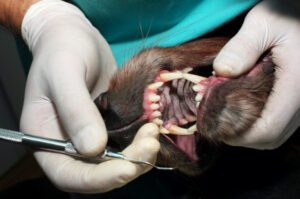by Janet Figarra, DVM
Often we tell our clients that their pet needs a “dental”. This can be a confusing term as it can mean different things to different people.

A Thorough Check
When we recommend a dental, what we mean to say is that your pet would benefit from a thorough dental cleaning under a general anesthetic. This allows us to evaluate all surfaces of the teeth for enamel defects/chips/cavities. We also check for periodontal pockets around each individual tooth. Dental radiographs are essential to look for abscesses, root remnants, resorptive lesions and abnormal bone. Depending on our findings, teeth may need to be extracted or we may need to take biopsies of abnormal tissues.

A patient with moderate to severe tartar & gingivitis (before and after procedure)
The Grade
We grade dental needs as levels 1-3 and charge accordingly. Some pets are evaluated as a ‘level 1’ which means there are no extractions needed. Our level 1 patients have a thorough oral examination and teeth are cleaned and polished. If a pet is categorized as needing a “level 2” dental, we are expecting extractions. This adds on the need for local anesthetic, radiographs, additional pain medication and possibly antibiotics. Level 3 patients need multiple extractions and/or radiographs or other dental surgery (oral-nasal fistula repair, etc.).
The Process
So, when your pet is in hospital for his/her dental, what do we do?
- A technician checks blood work to evaluate organ function and help us determine the safest and most effective anesthetic protocol for your pet.
- The veterinarian performs a pre-anesthetic exam on your pet, which includes listening to the heart and lungs for anything that might be of a concern for a patient undergoing anesthesia (e.g. heart murmur, congestion).
- The technicians and veterinarian give pre-anesthetic pain medication with or without a sedative as indicated by individual patient.
- An IV catheter is placed. An induction drug is given, causing relaxation so that we can place an endotracheal tube into the patient’s airway. At this time, general (gas) anesthesia is started and closely monitored by the attending anesthesia technician throughout the procedure.
- Sensors are placed to monitor blood pressure, pulse rate/oxygen saturation, etc. IV fluids are begun, and continued throughout procedures. Note that one technician is exclusively designated to monitor your pet throughout dental cleaning and recovery
- The attending veterinarian evaluates teeth and determines need for radiographs, extractions, etc.
- A licensed veterinary technician uses an ultrasonic scaler to clean the teeth, then she polishes the teeth with a pet-safe toothpaste. She also takes any necessary radiographs and places local anesthetic, if extractions are needed.
- The veterinarian performs necessary extractions, crown amputations, periodontal treatments, etc.
- Your pet is transported to heated cage in recovery where designated technician continues to monitor until awake and swallowing whereupon patient is extubated.
- The owner is called with an update and to discuss findings, treatments and recommendations.
Hopefully this will take some of the mystery out of the term “Dental”. Keep your pet chewing on rawhides, keep brushing their teeth and pray for good genes. But if this fails, don’t fear the ‘dental’.
Recent Posts
About Us
Ann Arbor Animal Hospital is a locally-owned animal hospital operating for over 90 years in Ann Arbor, MI.
